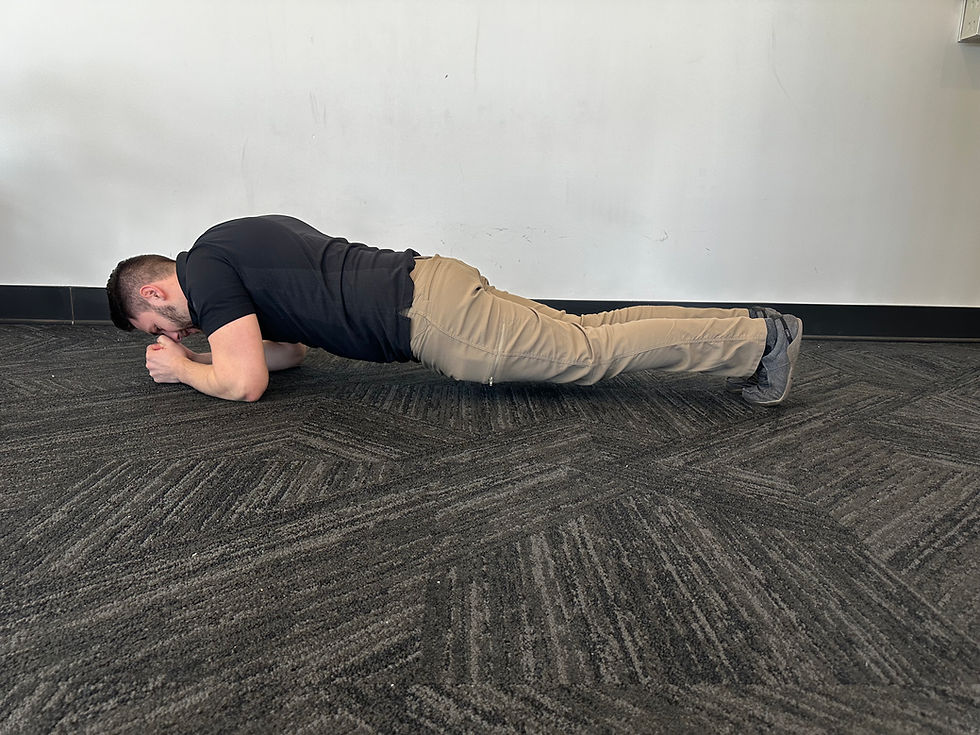Basic Push-Ups Exercise
- Benjamin Mishleau
- Feb 4
- 2 min read
Updated: Feb 20
The push-up has a long history, dating back to ancient civilizations where early forms of the movement were used in military training and physical conditioning. The exercise became more formally recognized during the 19th century when it was incorporated into physical education programs in the United States and Europe. Initially, push-ups were performed as part of calisthenic routines designed to improve general strength and fitness. Over time, the push-up evolved into various modifications and became a staple in military training, athletic conditioning, and general fitness routines due to its simplicity, versatility, and effectiveness. Today, push-ups are considered a foundational exercise for strength, endurance, and functional fitness, practiced worldwide in various forms, from basic to advanced variations.
Purpose: Build upper body strength, particularly in the chest, shoulders, and triceps, while also engaging the core and lower body for stability.
Targeted Areas: Pectorals, triceps, anterior deltoids
Instructions:
Begin in a plank position with your hands slightly wider than shoulder-width apart, fingers facing forward. Your feet should be together, and your body should form a straight line from head to heels.
Bend your elbows at a 45-degree angle and lower your body toward the ground, keeping your core engaged to prevent sagging in the lower back.
Push through your hands, straightening your arms to lift your body back up to the starting position.
Perform 8-10 repetitions or more for 2-3 sets.
Tips:
Keep your core tight to maintain a neutral spine and avoid sagging in the lower back.
Avoid flaring your elbows out too much; keep them at a 45-degree angle to protect your shoulders.
Engage your glutes and legs to stabilize the body and prevent arching.
Start with modified push-ups (on knees or with hands elevated) if you’re unable to perform full push-ups.
Who Should Do Push Ups:
General Fitness Enthusiasts – Great for individuals looking to build upper body strength, improve muscular endurance, and enhance core stability.
Athletes – Useful for athletes involved in sports requiring upper body power, like swimming, basketball, or martial arts.
Beginners – Push-ups can be easily modified (knees down, incline push-ups) for those just starting their fitness journey.
Individuals Looking to Improve Posture – By strengthening the chest, shoulders, and core, push-ups can help improve postural alignment.
Rehabilitation and Injury Recovery – Modified push-ups can be beneficial for building strength after shoulder, wrist, or chest injuries (under the guidance of a professional).
Who Shouldn’t Do Push Ups:
Individuals with Shoulder or Wrist Injuries – Push-ups put strain on the shoulders and wrists, so those with existing injuries or impingements may need to avoid or modify the exercise.
Those with Lower Back Pain – If unable to maintain proper spinal alignment or core stability, push-ups may aggravate lower back discomfort.
During Late Stage Pregnancy– Due to changes in core stability and balance, push-ups may become challenging, particularly in later stages of pregnancy. Modification is recommended.
People with Limited Upper Body Strength – Beginners with insufficient upper body strength might find traditional push-ups too challenging. Knee push-ups or wall push-ups are good alternatives to build strength before progressing to the full version.
Those with Limited Mobility or Flexibility – If you have difficulty bending your arms or keeping a neutral spine, the push-up may be difficult or potentially harmful without adjustments to the movement pattern.
If It Causes Pain: If in doubt, if it causes pain, don't do it.









Comments